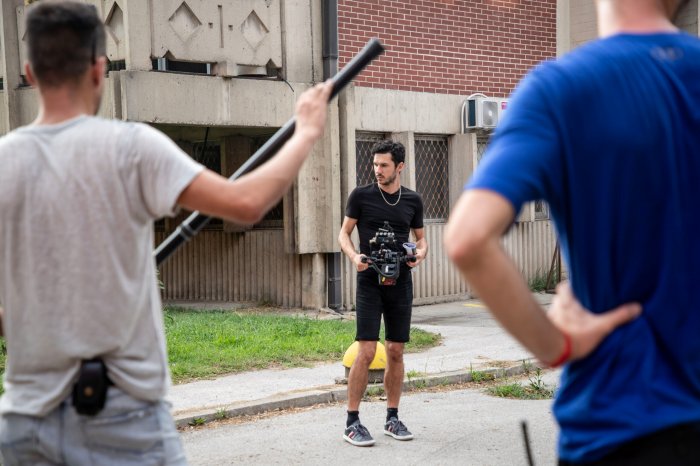If veteran documentarian Frederick Wiseman ever made a Western, I’m sure it would resemble “Sweetgrass.” In many respects, the film hews to the rules established by ’60s cinema verité. In fact, it goes further than many films from that period by throwing the spectator into an alien world without explaining any context. Lucien Castaing-Taylor eschews voice-over and interviews with his subjects. Apart from two intertitles that close the film, he also shies away from on-screen text.
“Sweetgrass,” however, also shows a self-conscious grasping for beauty that’s alien to the cinema verité ethos. In its austerity and reliance on gorgeous landscape shots, it has as much in common with Argentine minimalist Lisandro Alonso’s work as Wiseman’s. It offers the opportunity to take a vicarious trip to the Montana wilderness from the comfort and safety of Houston Street –– no need to worry about bear attacks! Surprisingly, it’s also quite self-conscious about the way it turns nature into a succession of postcard views. Without being hypocritical, Castaing-Taylor finds a way to have his beauty and interrogate it as well.
Lucien Castaing-Taylor documents sheep grazing and the cowboys who drive them
No human voices are heard during the first 20 minutes of “Sweetgrass.” Instead, the film introduces us to the world of sheep. Shot between 2001 and 2003 –– the editing took eight years –– in Montana’s Absaroka-Beartooth Mountains, it follows a group of modern-day cowboys as they drive thousands of sheep, taking an intimate view of the minutiae involved in taking care of the animals. One lamb is dressed in the wool of a dead relative so its mother will take care of it. The cowboys grip sheep between their legs in order to shear them with electric razors; although the sheep are in no pain or physical danger, one can’t help thinking of the technology of slaughterhouses.
Castaing-Taylor and his wife, Ilisa Barbash, who produced “Sweetgrass” and edited it with him, are academics. He’s a professor of anthropology as well as visual and environmental studies at Harvard. She’s a curator of visual anthropology at Harvard’s Peabody Museum.
Obviously, they come from a much different place than the cowboys they film, and only gradually does “Sweetgrass” come to feel like a film about people, rather than sheep. However, there’s no condescension in their gaze toward cowboys, and the film looks truly cinematic, rather than suggesting summer vacation footage from slumming professors. While it was shot on standard-definition video, its images of the Montana countryside are remarkably beautiful.
“Sweetgrass” evokes a wide range of cinematic precedents. Implicitly, it recalls the “hippie Westerns” of the late 1960s and early ’70s, such as Sam Peckinpah’s “Pat Garrett and Billy the Kid” and Arthur Penn’s “Little Big Man.” These films lamented the human cost of the West’s conquest; in its own way, “Sweetgrass” does much the same. Film Forum’s program notes recognize this, calling it “a paean to the waning world of the Old West.” Yet there’s no nostalgia in the film itself. If the old cowboy ways are dying, “Sweetgrass” lets the spectator decide whether or not that might be a good thing.
All the tensions implicit in “Sweetgrass” come to a head in its climactic scene. As a cowboy rants, the camera zooms backwards slowly from a typically gorgeous mountainside. While the view is breathtaking, the cowboy couldn’t care less. Amidst a long shot of the mountain, one can see that the sheep have stopped following a direct, linear path, instead becoming a tangled mass. Incongruously, the cowboy calls the sheep “bitches,” “cocksuckers,” and “motherfuckers.” His profanity is profuse and creative. Driven to the point of physical pain, he calls his wife on a cell phone. As he talks, the camera pans around the landscape. Castaing-Taylor shows how natural beauty and human misery can co-exist. The cowboy says, “I’d rather enjoy these mountains than hate them,” but the film makes clear that both are viable possibilities.
Cinema verité has widely been criticized for its pretensions of objectivity and its determined avoidance of personal engagement. The first-person documentaries of Michael Moore and Morgan Spurlock have achieved a popularity Wiseman could only dream about. Whatever Moore’s faults, no one can say he’s cagey about offering his opinions. “Sweetgrass” does, however, manage to stay out of its subjects’ way and let the viewer make up their own mind about them.
It’s possible to see the film as an elegy for a Wild West of individualism, freedom, and respect for nature. It’s just as possible to wonder whether driving sheep over ground by foot and horse, a technique no longer employed for the Absaroka-Beartooth herds, was simply a waste of time. Whatever one decides, Castaing-Taylor deserves a great deal of respect for documenting a dying tradition.
Complete Information:
SWEETGRASS
Directed by Lucien Castaing-Taylor
The Cinema Guild Opens Jan. 6
Film Forum
209 W. Houston St.


































